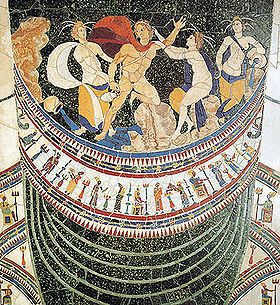
Basilica of Junius Bassus
Encyclopedia

Esquiline Hill
The Esquiline Hill is one of the celebrated Seven Hills of Rome. Its southern-most cusp is the Oppius .-Etymology:The origin of the name Esquilino is still under much debate. One view is that the Hill was named after the abundance of holm-oaks, exculi, that resided there...
in Rome, on a site now occupied by the Seminario Pontificio di Studi Orientali, in via Napoleone III, 3. It is best known for its examples of opus sectile
Opus sectile
Opus sectile refers to an art technique popularized in the ancient and medieval Roman world where materials were cut and inlaid into walls and floors to make a picture or pattern. Common materials were marble, mother of pearl, and glass. The materials were cut in thin pieces, polished, then trimmed...
work.
History
It was built by Junius Annius BassusJunius Annius Bassus
Iunius Annius Bassus was an ancient Roman politician.- Life :He served as praetorian prefect from 318 to 331, during which time he also held the consulate - many of the laws in the Codex Theodosianus are addressed to him...
in 331 during his consulate. In the second half of the 5th century, under pope Simplicius
Pope Simplicius
Pope Saint Simplicius was Pope from 468 to March 10, 483.He was born in Tivoli, Italy, the son of a citizen named Castinus. Most of what is known of him is derived from the Liber Pontificalis....
, it was transformed into the church of Sant'Andrea Catabarbara. Its last remains were rediscovered and demolished in 1930, and these excavations also found an Augustan
Augustus
Augustus ;23 September 63 BC – 19 August AD 14) is considered the first emperor of the Roman Empire, which he ruled alone from 27 BC until his death in 14 AD.The dates of his rule are contemporary dates; Augustus lived under two calendars, the Roman Republican until 45 BC, and the Julian...
house (with later rebuilding) containing 3rd century mosaics, one with Dionysian subjects and one with the names of the house's owners (Arippii and Ulpii Vibii). These mosaics are now on show in the seminary.

